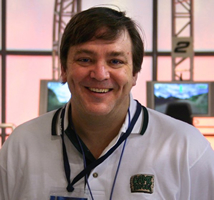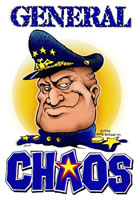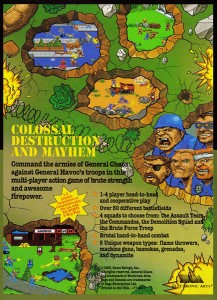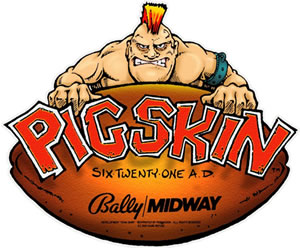 Many Genesis owners have fond memories of General Chaos. The multi-player battles against friends could be epic, and the game made excellent use of Electronic Arts’ four-player multi-tap (it was among the first games to use the new peripheral). What they don’t know is the storied history behind the developer that made the Genesis classic. Game Refuge was composed of people with an incredible amount of experience in the gaming industry, including people who worked on several bonfide arcade classics.
Many Genesis owners have fond memories of General Chaos. The multi-player battles against friends could be epic, and the game made excellent use of Electronic Arts’ four-player multi-tap (it was among the first games to use the new peripheral). What they don’t know is the storied history behind the developer that made the Genesis classic. Game Refuge was composed of people with an incredible amount of experience in the gaming industry, including people who worked on several bonfide arcade classics.
One of those people is Brian Colin. Before founding Game Refuge and other ventures, he spent a decade as a designer, artist and animator at Bally Midway. There, he played an integral role in the creation of such arcade classics as Xenophobe, Discs of Tron and Spy Hunter. After setting off on his own in 1992, Colin went on to make games for the Genesis as well as coin-ops like Rampage World Tour and Star Trek: Voyager.
Recently, Mr. Colin chatted with Sega-16 about his work in gaming and the development of Game Refuge’s Genesis titles.
Sega-16: You and Jeff Nauman left Williams Bally/Midway to form Game Refuge in 1992. You’ve said that a former Electronic Arts producer had been trying to bring the two of you out to California to work for the company for some time, until he suggested that you start your own company. Was this EA contact influential in you pitching your first game, General Chaos, to EA?
Brian Collin: Absolutely!
The story of Game Refuge and the story of how General Chaos came to be are really one and the same. EA producer Richard Robbins contacted me out of the blue one day and asked if I’d consider coming to work for EA. The thought of doing games for EA was very appealing, but I wasn’t really interested in relocating to California. Jeff and I were working out of our homes two-three days a week at that time, and I was pretty happy with the flexibility in my current situation. After several weeks of exchanging employment options & possibilities, Rich made me a very attractive offer: he hinted that if Jeff and I started our own company, EA would do whatever game we wanted to do, sight unseen!
As great as that sounds, it was still quite a big risk for us, since we couldn’t sign any papers, discuss any terms or even talk about what the first game might be until after we left Williams-Bally/Midway. It took me a few months to convince Jeff to come on board, but eventually we took a “leap of faith” and quit our jobs, traveled across the country and pitched our game to a roomful of total strangers.
Fortunately, they loved the game, (or at least pretended to), and except for a brief moment when someone asked if we’d consider making it a gang war, (we wouldn’t), the meeting was a smooth and thoroughly enjoyable experience. Game Refuge & General Chaos were born.
Sega-16: How did you come up with the concept of General Chaos? What influenced its creation?
 Brian Colin: Maybe it goes back to childhood days when a handful of army men in a sandbox, (and a little imagination), was all I needed to keep myself amused for hours at a time… but I’ve always loved the idea of giving players the ability to control several characters at a time.
Brian Colin: Maybe it goes back to childhood days when a handful of army men in a sandbox, (and a little imagination), was all I needed to keep myself amused for hours at a time… but I’ve always loved the idea of giving players the ability to control several characters at a time.
When I first got into the industry in 1982, Bally Midway had a number of game concepts “on the drawing board” that hadn’t been fleshed out yet. I was fortunate enough to be given the freedom to put my spin on them and was able turn a couple of them into finished prototypes. Kozmik Krooz’r (previously Mothership) was one such game, and another was a simple two-player strategy & tactics concept called Ant Raid in which ants battled for food scattered around a garbage dump. Though Ant Raid was never released, it proved that the concept of controlling an entire squad of smart A.I. characters was not only possible, it was fun!
Looking backwards from General Chaos at our previous arcade work, the progression of squad based gameplay is pretty clear… our last arcade game for Midway, Pigskin 621, allowed players to control a six-man team of sword-wielding rugby enthusiasts. It’s predecessor, Arch Rivals was the first game to let players use real basketball strategies because they were controlling a two-man basketball team instead of a single character, and even Sarge let players pretend to be a one-man army by jumping back and forth between a tank and a helicopter.
In the end, General Chaos was just a natural extension of the little kid in the sandbox saying “you go here, you go over there, and you, you guard this dump truck with your LIFE…!”
Sega-16: General Chaos plays best in multi-player, and it was one of the first Genesis titles to use a four-player adapter. Did you always plan to allow that many players or was it something that was added during development?
Brian Colin: Nearly all of our most successful arcade hits were designed for simultaneous multi-player play. I never understood the point of forcing one player to wait and watch someone else play, when including them in the action makes any game so much more fun and interesting for everyone. The whole point of General Chaos was to let players go “head-to-head” in a mad scramble for supremacy.
Now, having said that, the game was originally designed as a two-player game only; we were unaware of the existence of the new four-player control adapter until we we’re half way through the project. I always felt that we could have done a little more with it had we planned for it from the start.
Sega-16: One of the main complaints about General Chaos is that it’s too short! Many people consider it to be too arcade-like in this aspect, along with things like score and the lack of an overall narrative. Can this be attributed to your arcade roots and inexperience with the console market?
Brian Colin: Interesting… I can honestly say that that’s one complaint I’ve never heard. Quite the opposite in fact; most fans tell us that they love the fact that the game was all about the battle, with none of the tiresome resource building that subsequent strategy & tactics games would force players to sit through in later years. Our battles are, by design, just a small part of the bigger picture, the war. We gave the players over 50+ battlegrounds to choose from to insure that every war was different every time. We wanted a game that could stay fresh and be played repeatedly, as opposed to games that once you’ve played them through, you’re done.
As for the decision to remove the score from the playfield: screen real estate was a big challenge in General Chaos. There was a LOT that we had to squeeze onto that playfield, and ultimately, we felt that since it was primarily about who won & who lost, we could save scoring & bonuses for between rounds.
From a design standpoint, my feeling regarding a narrative or back-story was (and is) that it’s great when the system resources have enough overhead to make a narrative possible without sacrificing game elements, but when space/memory is at a premium (as it often was in those early days), I always felt resources were better spent on game play & game depth, not splash screens. I enjoy games with a great narrative, but gameplay should always come first. If the story is the driving force, the game is usually just played once.
So, I’d have to say that “yes,” our arcade roots were a definitive factor in why we designed the game the way we did. In fact, we were told that our “arcade approach” to game design was one of the reasons EA sought us out in the first place!
Designing for the arcade means designing for a broad range of people. Some folks are looking for strategy, some a new skill to learn & master, and some just want to slap the buttons as hard and as fast as they can. If they can all find what they want in the same game, you’ve succeeded.
In any case, I’m not sure if more console experience would have changed our approach for the better. The game was EA’s number two-selling original (non license) title that year, & I still get more fan mail for this game than any of the nearly seventy titles I’ve created over the years. So overall, I’m pretty happy with the tradeoffs we made.
 Sega-16: What do you feel were the biggest complaints or drawbacks about General Chaos?
Sega-16: What do you feel were the biggest complaints or drawbacks about General Chaos?
Brian Colin: Based on Internet fan reviews & player feedback over the years, the number one complaint about the game was that using the D-pad control configuration to select and direct the different squad members was difficult to master. As a result, players often resorted to “button mashing” whenever things got too overwhelming.
Oddly enough, others claim that they found the frantic smashing of the controls to be addictive & every bit as effective; depending on the skills of the opponent. When all was said and done, I guess it was satisfying if you could master the controls, and perversely satisfying even if you couldn’t.
Which kind of fits with one of my basic arcade design philosophies: There should be no wrong way to play a game.
Sega-16: Were there deeper gameplay elements you wanted to implement but couldn’t?
Brian Colin: At the time, no. When we create a game, we try to start with as detailed a design doc as possible; which means that we pretty much know what we’ve got to work with & and what is, (and what is not), possible before the first pixel gets pushed around. Although it’s true that no battle plan ever lasts past the first skirmish, having a good game plan is essential for bringing a title in on time and on budget. So, the game you saw was pretty much the game we set out to do, and we filed our “what ifs” away for implementation in the sequel, Major Snafu.
Over the years, of course, we’ve continued to daydream about re-doing it on a current system, so the list of things we’d love to add to General Chaos just keeps growing and growing.
Sega-16: What would you do differently if you were making General Chaos today?
Brian Colin: It’s been our dream to revisit or reinvent the General’s world and take advantage of today’s technology. We’d add touchscreen controls so you can simply touch him and send him there, multi-player contests across Internet/LAN to give each player his own battlefield view, scrolling battlefields & dynamic cameras so players can sneak up & out flank each other, additional Grunt types, additional weapon capabilities, player selectable battle plans & standing orders, new squad formations and squad movement options, vehicle use, richly detailed 3D environments, new tactical terrain options; non-combatants, innocent bystanders, and a rebel resistance; looting, pillaging, plundering and a whole lot more…
… and we’re currently making this dream come true… I can’t really tell you more than than right now, check back with us in about a month.
Sega-16: You were one of the minds behind the arcade hit Arch Rivals. What did you think of the Genesis port? Did you have any input in its development?
Brian Colin: I loved the Mort Drucker-style box art! Beyond that, well… I’m a little embarrassed to say I seldom played any of the ports to our games… since I had the original arcade cabinets in my basement, garage or office. We basically had little or nothing to do with the vast majority of them. Management would license them to so-&-so, and we’d find out about it when we’d see the games on the store shelves.
Sega-16: You worked on a baseball-themed sequel to Arch Rivals called Wild Pitch that never got released because management believed baseball games weren’t suited for the arcade. You’ve also said that whenever it was shown to the public, it proved it to be quite popular. Do you think it could have found its audience had it been ported to home consoles? Was the idea ever pitched to management?
Brian Colin: I think it would have made a terrific home console game, and we talked about the home version possibilities a lot with management during development. But the prototype game was plagued with erratic test numbers, and Midway decided to pull the plug. While it’s true that, subsequently, our Wild Pitch prototype was enormously popular with players in our Mobile Arcade, no serious thought was given to its resurrection. In those days, Midway was first and foremost a manufacturer; there was never any discussion about a game being developed for a console unless it was sold as a successful arcade cabinet first.
 Sega-16: Another arcade success of yours, Pigskin 621 A.D. found its way to the Genesis as Jerry Glanville’s Pigskin Footbrawl under Razorsoft. Do you think it did justice to the original?
Sega-16: Another arcade success of yours, Pigskin 621 A.D. found its way to the Genesis as Jerry Glanville’s Pigskin Footbrawl under Razorsoft. Do you think it did justice to the original?
Brian Colin: Oddly enough, this is one of the few ports that we were really looking forward to, as Razorsoft actually called us a couple of times during its creation and invited us to a couple of pretty impressive release parties! Unfortunately, I was surprised and disappointed in the actual look of this port. They simply slapped our game’s art files into the port without adjusting for the different pixel aspect ratios, which resulted in oddly stretched characters.
Sega-16: Your games tend to follow a competitive, combative style. Is this deliberate? Each game has been successful, so you’ve obviously tapped into something gamers enjoy, but did each project start out with this direction in mind?
Brian Colin: As noted previously, I like multi-player games because I think it adds to the unpredictability and excitement, and I like punching & kicking and close combat because I find it funnier and more personal when you can see the pain on the other guy’s face… I suppose that even when players try to cooperate some competition always creeps into the mix, so there’s always gonna be competition in there as well, but do I start out with these things in mind?
I make games for me. I make games that I want to play but can’t because no one’s made them yet.
I never really thought about in these terms before, but yes, since my sense of humor and what I enjoy is always a part of everything I do, I guess that most of my games start out coming from the same direction. It’s not conscious or deliberate, just a happy accident.
Sega-16: General Chaos was supposed to have a sequel, Major Snafu, but it was never released. What happened?
Brian Colin: Corporate confusion &/or bad timing. We were about three months into our next two Genesis titles, Major Snafu and Plunder, when EA told us that they were forming a new “arcade division” and they needed us to drop what we were doing to help them create their new division’s second arcade title. So we scrapped those Genesis titles and started developing RC Squared, an arcade game that let players race indestructible radio-controlled cars through heavily populated areas. Unfortunately, EA’s first arcade title was a version of their number-one-selling title on all systems, Madden Football. Earnings on the Madden arcade version were so dismal that the entire division was shut down a few months before RC Squared was completed. (Apparently, people didn’t want to pay to play a game that they already had at home.) By the time the smoke cleared, another year had elapsed and Genesis games were no longer on EA’s list of top priorities.
Sega-16: Tell us a bit about Plunder. What was the game about? Was it a victim of the same factors that shelved Major Snafu?
Brian Colin: I can’t really say what Plunder was about without giving away what may be the coolest two-player, squad based game of all time, sorry. (I hope to revive it someday…). And, yes, it was abandoned the same time as Major Snafu.
Sega-16: Rampage saw ports to the Sega Master System, NES and other consoles. Was there ever any discussion to bring the franchise to the Genesis or SNES? Did you ever approach or were you approached by Atari Corporation about doing something with the license?
Brian Colin: Nope & nope.
We did the original Rampage for Bally Midway as employees, and 10 years later we did Rampage World Tour as Game Refuge, an independent developer. As noted above, no one really bothered to talk to us about these things when we were simple employees, and later, as outside developers, we didn’t own the rights, so no one had a reason to approach us then, either.
Our thanks to Mr. Colin for taking the time to chat with us. We look forward to what Game Refuge comes up with next!

Great interview as always!